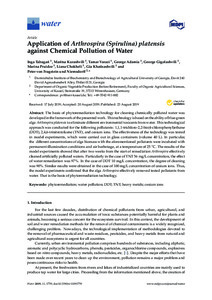Datum
2019-08-23Autor
Tabagari, IngaKurashvili, MaritsaVarazi, TamarAdamia, GeorgeGigolashvili, GeorgePruidze, MarinaChokheli, LianaKhatisashvili, GiaFragstein und Niemsdorff, Peter vonSchlagwort
630 Landwirtschaft, VeterinärmedizinMetadata
Zur Langanzeige
Aufsatz

Application of Arthrospira (Spirulina) platensis against Chemical Pollution of Water
Zusammenfassung
The basis of phytoremediation technology for cleaning chemically polluted water was developed in the framework of the presented work. This technology is based on the ability of blue-green alga Arthrospira platensis to eliminate different environmental toxicants from water. This technological approach was conducted for the following pollutants: 1,1,1-trichloro-2,2-bis(4-chlorophenyl)ethane (DDT), 2,4,6-trinitrotoluene (TNT), and cesium ions. The effectiveness of the technology was tested in model experiments, which were carried out in glass containers (volume 40 L). In particular, the different concentrations of alga biomass with the aforementioned pollutants were incubated with permanent illumination conditions and air barbotage, at a temperature of 25 °C. The results of the model experiments showed that after two weeks from the start of remediation Arthrospira effectively cleaned artificially polluted waters. Particularly in the case of TNT 56 mg/L concentration, the effect of water remediation was 97%. In the case of DDT 10 mg/L concentration, the degree of cleaning was 90%. Similar results were obtained in the case of 100 mg/L concentration of cesium ions. Thus, the model experiments confirmed that the alga Arthrospira effectively removed tested pollutants from water. That is the basis of phytoremediation technology.
Zitierform
In: Water Vol. 11 / 9 (2019-08-23) , S. 1759 ; ISSN 2073-4441Förderhinweis
Gefördert durch den Publikationsfonds der Universität KasselZitieren
@article{doi:10.17170/kobra-20190903647,
author={Tabagari, Inga and Kurashvili, Maritsa and Varazi, Tamar and Adamia, George and Gigolashvili, George and Pruidze, Marina and Chokheli, Liana and Khatisashvili, Gia and Fragstein und Niemsdorff, Peter von},
title={Application of Arthrospira (Spirulina) platensis against Chemical Pollution of Water},
journal={Water},
year={2019}
}
0500 Oax 0501 Text $btxt$2rdacontent 0502 Computermedien $bc$2rdacarrier 1100 2019$n2019 1500 1/eng 2050 ##0##http://hdl.handle.net/123456789/11295 3000 Tabagari, Inga 3010 Kurashvili, Maritsa 3010 Varazi, Tamar 3010 Adamia, George 3010 Gigolashvili, George 3010 Pruidze, Marina 3010 Chokheli, Liana 3010 Khatisashvili, Gia 3010 Fragstein und Niemsdorff, Peter von 4000 Application of Arthrospira (Spirulina) platensis against Chemical Pollution of Water / Tabagari, Inga 4030 4060 Online-Ressource 4085 ##0##=u http://nbn-resolving.de/http://hdl.handle.net/123456789/11295=x R 4204 \$dAufsatz 4170 7136 ##0##http://hdl.handle.net/123456789/11295
<resource xsi:schemaLocation="http://datacite.org/schema/kernel-2.2 http://schema.datacite.org/meta/kernel-2.2/metadata.xsd"> 2019-09-05T07:25:23Z 2019-09-05T07:25:23Z 2019-08-23 doi:10.17170/kobra-20190903647 http://hdl.handle.net/123456789/11295 Gefördert durch den Publikationsfonds der Universität Kassel eng Urheberrechtlich geschützt https://rightsstatements.org/page/InC/1.0/ phytoremediation water pullution DDT TNT heavy metals cesium ions 630 Application of Arthrospira (Spirulina) platensis against Chemical Pollution of Water Aufsatz The basis of phytoremediation technology for cleaning chemically polluted water was developed in the framework of the presented work. This technology is based on the ability of blue-green alga Arthrospira platensis to eliminate different environmental toxicants from water. This technological approach was conducted for the following pollutants: 1,1,1-trichloro-2,2-bis(4-chlorophenyl)ethane (DDT), 2,4,6-trinitrotoluene (TNT), and cesium ions. The effectiveness of the technology was tested in model experiments, which were carried out in glass containers (volume 40 L). In particular, the different concentrations of alga biomass with the aforementioned pollutants were incubated with permanent illumination conditions and air barbotage, at a temperature of 25 °C. The results of the model experiments showed that after two weeks from the start of remediation Arthrospira effectively cleaned artificially polluted waters. Particularly in the case of TNT 56 mg/L concentration, the effect of water remediation was 97%. In the case of DDT 10 mg/L concentration, the degree of cleaning was 90%. Similar results were obtained in the case of 100 mg/L concentration of cesium ions. Thus, the model experiments confirmed that the alga Arthrospira effectively removed tested pollutants from water. That is the basis of phytoremediation technology. open access Tabagari, Inga Kurashvili, Maritsa Varazi, Tamar Adamia, George Gigolashvili, George Pruidze, Marina Chokheli, Liana Khatisashvili, Gia Fragstein und Niemsdorff, Peter von doi:10.3390/w11091759 publishedVersion ISSN 2073-4441 9 Water 1759 Vol. 11 </resource>
Die folgenden Lizenzbestimmungen sind mit dieser Ressource verbunden:
Urheberrechtlich geschützt

